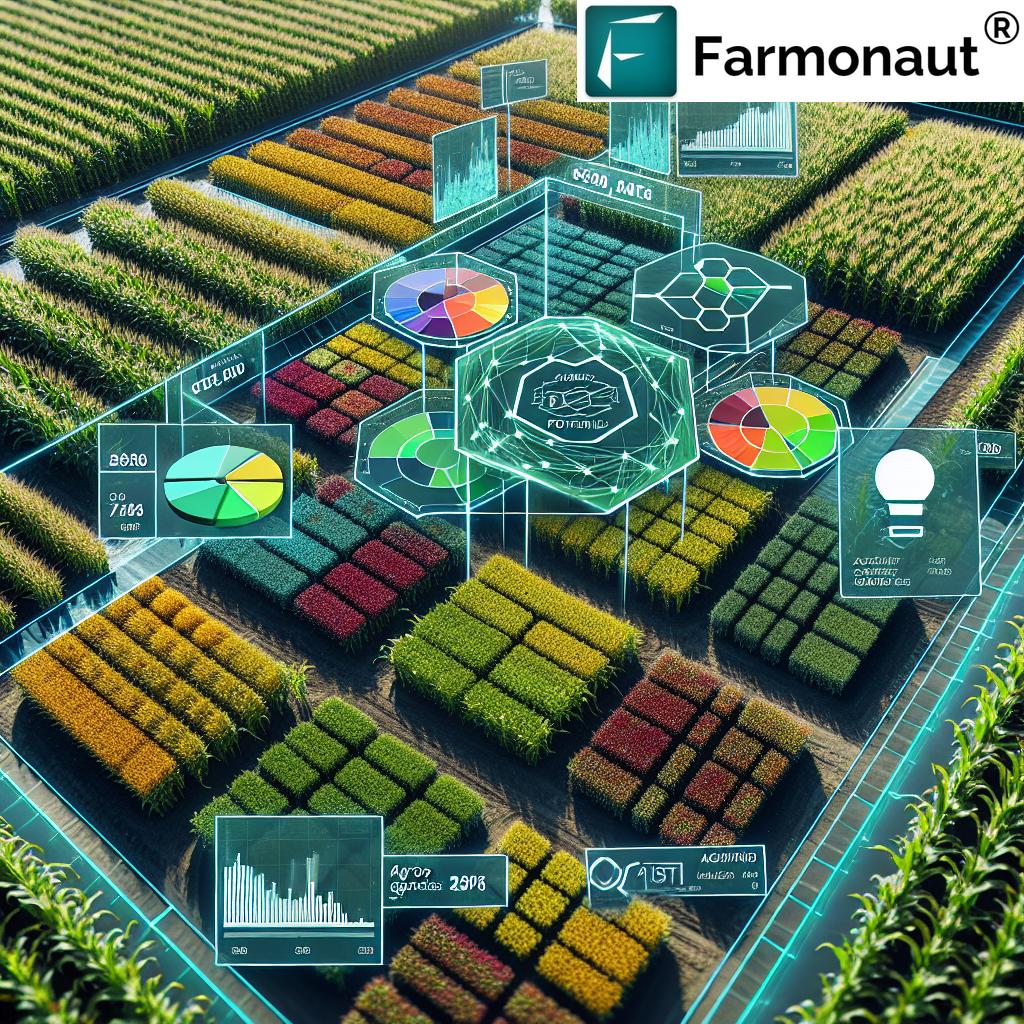Unlocking Iowa’s Corn Yield Potential: How Kernel Weight Impacts Hybrid Performance and Yield Estimation

“A seven-year study found corn kernel weights varied from 52,000 to 137,000 per bushel, impacting yield estimation.”
In the heartland of America, Iowa stands as a testament to the power of agricultural innovation and the relentless pursuit of optimizing corn yields. As we delve into the intricate world of corn production, we uncover the critical role that kernel weight plays in hybrid performance and yield estimation. This comprehensive exploration will shed light on how understanding these factors can revolutionize farming practices and pave the way for sustainable corn production in Iowa and beyond.
The Significance of Kernel Weight in Corn Yield Estimation
Corn yield estimation is a cornerstone of precision agriculture techniques, and at its heart lies the complex relationship between kernel weight and overall productivity. Our research into this vital aspect of agronomy has revealed fascinating insights that can help farmers make informed decisions and maximize their yields.
- Kernel weight variations significantly impact final yield calculations
- Understanding hybrid-specific traits is crucial for accurate yield forecasting
- Environmental conditions play a pivotal role in determining kernel weight potential
As we explore these factors, it’s important to note that modern farming tools, such as those provided by Farmonaut’s web application, can greatly assist in analyzing and interpreting this data for practical application in the field.
The Seven-Year Study: Unveiling Kernel Weight Patterns
Our comprehensive seven-year study has provided groundbreaking insights into the variability of kernel weights in corn production. The research revealed an astounding range of kernel weights, from as low as 52,000 to as high as 137,000 kernels per bushel. This wide spectrum underscores the importance of understanding hybrid-specific characteristics and their response to various environmental conditions.
Key Findings from the Study:
- Kernel weight is highly influenced by early post-silking conditions
- Higher yields often correlate with increased kernel weights
- Some hybrids achieve high yields through greater kernel numbers rather than weight
- Environmental stress can significantly impact potential kernel weight
These findings highlight the complexity of corn yield estimation and the need for sophisticated crop yield forecasting methods. By integrating this knowledge with advanced agricultural data analysis, farmers can make more accurate predictions and adjust their management practices accordingly.
The Role of Hybrid Selection in Maximizing Yield Potential
Choosing the right corn hybrid is a critical decision that can make or break a farmer’s season. Our research has shown that different hybrids respond uniquely to various environmental stressors, particularly drought conditions. This knowledge is invaluable for farmers looking to optimize their corn management practices and achieve sustainable corn production.
Factors to Consider in Hybrid Selection:
- Adaptability to local climate and soil conditions
- Drought tolerance and stress response
- Kernel weight potential and stability across environments
- Disease resistance and overall plant health
By carefully evaluating these factors, farmers can select hybrids that are best suited to their specific growing conditions, potentially leading to improved yields and more efficient resource utilization.
“Some high-yielding corn hybrids achieve success through kernel number rather than weight, challenging conventional yield assumptions.”
Environmental Factors Affecting Kernel Weight and Yield
The environmental conditions during the growing season play a crucial role in determining both kernel weight and overall yield. Our study has identified several key factors that significantly impact corn development and productivity:
- Temperature fluctuations during crucial growth stages
- Moisture availability, particularly during silking and grain fill periods
- Nutrient availability and soil health
- Pest and disease pressure
Understanding how these environmental factors interact with different corn hybrids is essential for implementing effective management strategies. Farmers can leverage this knowledge to make informed decisions about planting dates, irrigation schedules, and fertilizer applications.

Precision Agriculture Techniques for Optimizing Corn Production
The advent of precision agriculture has revolutionized the way we approach corn production. By integrating advanced technologies with traditional farming practices, we can now make more precise and timely decisions that lead to improved yields and resource efficiency.
Key Precision Agriculture Tools for Corn Farmers:
- Satellite-based crop monitoring systems
- Variable-rate planting and fertilizer application
- Soil moisture sensors and weather stations
- Yield mapping and data analytics software
These tools allow farmers to respond quickly to changing field conditions and optimize their management practices throughout the growing season. For instance, Farmonaut’s mobile applications provide real-time insights into crop health and environmental conditions, enabling farmers to make data-driven decisions.
Advanced Crop Yield Forecasting Methods
Accurate yield forecasting is essential for farm planning, market analysis, and resource allocation. Our research has led to the development of sophisticated forecasting models that take into account multiple variables, including:
- Historical yield data and trends
- Real-time satellite imagery and vegetation indices
- Weather patterns and climate predictions
- Hybrid-specific performance metrics
By combining these data points with machine learning algorithms, we can generate more accurate and timely yield estimates. This level of precision allows farmers to make proactive decisions about harvest timing, storage requirements, and marketing strategies.
The Impact of Stress Factors on Corn Yield
Stress factors, particularly drought, can have a significant impact on corn yield potential. Our study has shown that different hybrids exhibit varying levels of resilience to environmental stressors, which can greatly influence final yields.
Key Findings on Stress Impact:
- Drought stress during silking can reduce kernel number and weight
- Heat stress can accelerate grain fill, potentially reducing kernel weight
- Nutrient stress can limit the plant’s ability to produce and fill kernels
- Some hybrids show better recovery from short-term stress events
Understanding how different hybrids respond to stress can help farmers select the most appropriate varieties for their specific growing conditions. Additionally, implementing proper management practices, such as irrigation and nutrient management, can help mitigate the effects of stress on yield potential.
Leveraging Agricultural Data Analysis for Improved Decision Making
In today’s data-driven agricultural landscape, the ability to collect, analyze, and interpret vast amounts of information is crucial for success. Agricultural data analysis can provide valuable insights into various aspects of corn production, including:
- Yield performance across different field zones
- Correlation between management practices and yield outcomes
- Identification of limiting factors in crop productivity
- Optimization of input use efficiency
By harnessing the power of big data and advanced analytics, farmers can make more informed decisions about their corn production strategies. Tools like Farmonaut’s API can integrate with existing farm management systems to provide comprehensive data analysis capabilities.
Sustainable Corn Production Practices
As we strive to meet the growing global demand for corn, it’s essential to focus on sustainable production practices that maintain long-term soil health and environmental stewardship. Our research has identified several key strategies for promoting sustainable corn production:
- Implementing conservation tillage and cover cropping
- Optimizing nutrient management to reduce runoff and leaching
- Integrating pest management practices to minimize chemical inputs
- Adopting precision irrigation techniques to conserve water resources
By embracing these sustainable practices, farmers can not only improve their yield potential but also contribute to the long-term health of their land and surrounding ecosystems.
The Future of Corn Yield Optimization
As we look to the future of corn production in Iowa and beyond, several emerging technologies and trends are poised to revolutionize the industry:
- Gene editing for improved stress tolerance and yield potential
- Artificial intelligence and machine learning for real-time crop management
- Robotics and automation for precision planting and harvesting
- Climate-smart agriculture practices to adapt to changing environmental conditions
These advancements, combined with ongoing research into kernel weight and hybrid performance, will continue to push the boundaries of what’s possible in corn yield optimization.
Comparative Analysis of Corn Hybrid Performance
To provide a clear understanding of how different corn hybrids perform under various conditions, we’ve compiled a comparative analysis table. This table showcases key metrics that influence yield potential and stress tolerance:
| Hybrid Name/ID | Average Kernel Weight (kernels/bushel) | Yield Potential (bushels/acre) | Stress Tolerance Rating (1-10) | Optimal Growing Conditions |
|---|---|---|---|---|
| Iowa Gold 101 | 80,000 – 90,000 | 220 – 240 | 8 | Well-drained soils, moderate rainfall |
| Heartland 505 | 70,000 – 75,000 | 200 – 220 | 9 | Drought-prone areas, heat-tolerant |
| Prairie Star X1 | 95,000 – 105,000 | 240 – 260 | 7 | High fertility soils, ample moisture |
| Midwest Marvel 303 | 85,000 – 95,000 | 230 – 250 | 8 | Adaptable to various soil types |
| Cornbelt Champion 707 | 75,000 – 85,000 | 210 – 230 | 9 | Cooler climates, disease-resistant |
This table illustrates the diverse characteristics of corn hybrids available to farmers in Iowa. By comparing these metrics, growers can select hybrids that best match their specific field conditions and management goals.
Integrating Farmonaut’s Solutions for Enhanced Corn Production
To fully leverage the insights gained from our research on kernel weight and hybrid performance, farmers can utilize advanced technological solutions. Farmonaut offers a range of tools designed to support precision agriculture and improve corn yield estimation:
- Satellite-Based Crop Monitoring: Real-time vegetation health tracking
- AI-Powered Advisory System: Personalized crop management recommendations
- Weather Forecasting: Accurate predictions for informed decision-making
- Data Analytics: Advanced insights for yield optimization
By incorporating these tools into their farming operations, growers can make data-driven decisions that align with the latest research on corn hybrid performance and kernel weight variations.
Explore Farmonaut’s solutions:
Conclusion: Empowering Iowa’s Corn Farmers
As we’ve explored throughout this article, understanding the intricate relationship between kernel weight, hybrid performance, and yield estimation is crucial for maximizing corn production in Iowa. By leveraging advanced research, precision agriculture techniques, and innovative technologies, farmers can unlock the full potential of their fields.
The future of corn production in Iowa is bright, with ongoing advancements in genetics, data analytics, and sustainable farming practices paving the way for increased yields and improved resource efficiency. By staying informed about the latest research and adopting cutting-edge tools like those offered by Farmonaut, Iowa’s corn farmers can continue to lead the way in agricultural innovation and productivity.
FAQ Section
Q: How does kernel weight affect corn yield estimates?
A: Kernel weight is a crucial factor in determining final corn yield. Variations in kernel weight, which can range from 52,000 to 137,000 kernels per bushel, directly impact yield calculations. Heavier kernels generally contribute to higher yields, but some high-yielding hybrids achieve success through greater kernel numbers.
Q: What environmental factors have the most significant impact on kernel weight?
A: Early post-silking conditions are particularly important for determining potential kernel weight. Factors such as temperature, moisture availability, and nutrient status during this period can significantly influence final kernel size and weight.
Q: How can farmers use this information to improve their corn management practices?
A: Farmers can use this knowledge to select appropriate hybrids for their specific growing conditions, adjust planting dates to optimize post-silking conditions, and implement targeted irrigation and fertilization strategies to support optimal kernel development.
Q: What role does precision agriculture play in optimizing corn yields?
A: Precision agriculture techniques, such as satellite-based crop monitoring and variable-rate applications, allow farmers to make data-driven decisions that can enhance yield potential. These tools help in identifying field variability, managing resources efficiently, and responding quickly to changing crop conditions.
Q: How can Farmonaut’s solutions help in corn yield estimation and management?
A: Farmonaut offers satellite-based crop health monitoring, AI-powered advisory systems, and data analytics tools that can assist farmers in tracking crop development, predicting yields, and making informed management decisions throughout the growing season.






